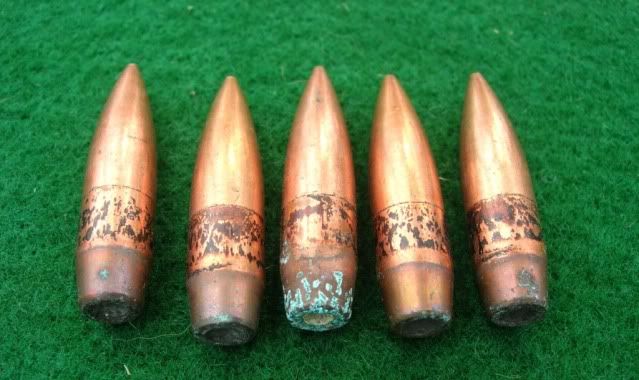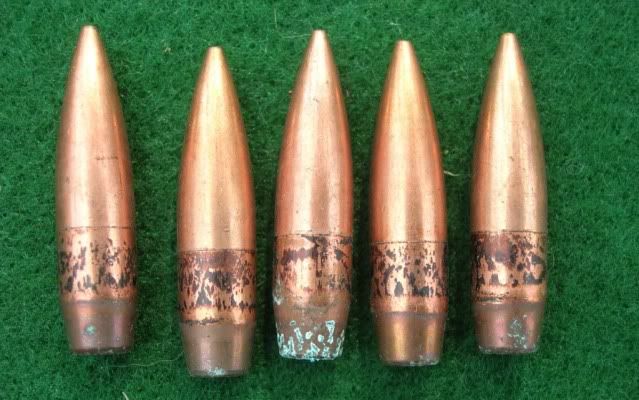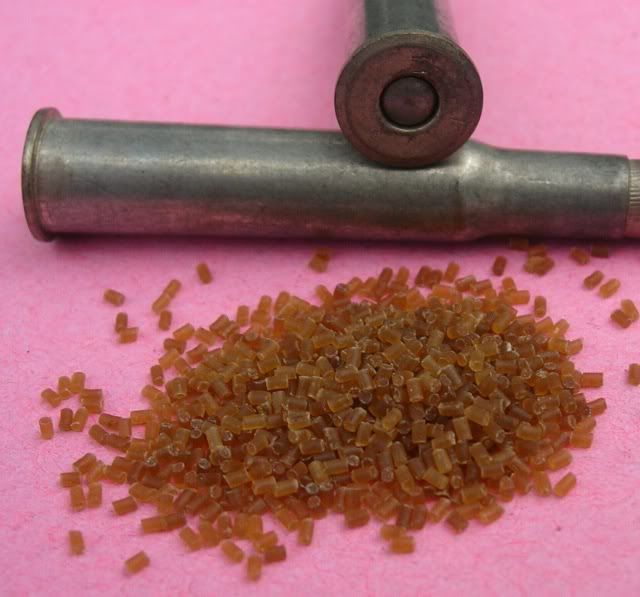
 |
|
|
#1 |
|
Junior Member
Join Date: April 15, 2011
Location: Prairie Village Kansas
Posts: 7
|
Does Powder Go Bad??
I have an almost full canister of Bullseye, Blue Dot, IMR 4895 and the bottom end of a 5 lb can of 2400.
These have been on the shelf in the basement in a climate controlled environment for 15 years. Life sort of got me away from reloading and I am gearing back up to start reloading again. So, does powder go bad after a certain length of time? Thanks Rocky |
|
|
|
|
#2 |
|
Senior Member
Join Date: April 6, 2009
Location: SWPA
Posts: 428
|
The powder should be OK; I would load up a few test loads first.
I have shot a bunch of Mil – Surplus from the 40s and it fired fine. If kept in the original container and no humidity you will be fine. I have a can of Red dot I know is 20 years old and is still good. |
|
|
|
|
#3 |
|
Junior member
Join Date: April 18, 2008
Location: N. Central Florida
Posts: 8,518
|
Depends - some powders do well after 50-75 years - if it isn't smelling bad - it should be OK. They have been testing an original batch of Unique since it was created - stored under water, it still works fine
|
|
|
|
|
#4 |
|
Senior Member
Join Date: December 1, 2002
Posts: 2,832
|
Yeah, "old" powder does go bad. Fifteen years is still like brand-new tho.
|
|
|
|
|
#5 |
|
Senior Member
Join Date: January 28, 2009
Location: Key West
Posts: 162
|
If stored properly powder will out live all of us here.
|
|
|
|
|
#6 |
|
Junior member
Join Date: October 4, 2007
Location: All the way to NEBRASKA
Posts: 8,722
|
Pour some out on a white piece of paper.... if there's red or rusty powder in it, it's bad.
|
|
|
|
|
#7 |
|
Junior Member
Join Date: April 15, 2011
Location: Prairie Village Kansas
Posts: 7
|
Thanks for your replies. I feel at ease now using the powder I have instead of having to go buy new.
Rocky |
|
|
|
|
#8 |
|
Senior Member
Join Date: February 23, 2005
Location: Helena, Mt.
Posts: 122
|
I agree with the previous posts, but one thing to watch for is rust. Some of the older IMR metal containers can develop internal rust, which can be confused with powder deterioration.
|
|
|
|
|
#9 |
|
Member in memoriam
Join Date: April 9, 2009
Location: Blue River Wisconsin, in
Posts: 3,144
|
I'm still using some 4350 I bought in 1976 and it works fine. For 20 years while I was in Illinois and unable to shoot it was in a sealed can inside a ammo can stored in an unheated storage shed. I can't see where it has been hurt any.
__________________
Good intentions will always be pleaded for any assumption of power. The Constitution was made to guard the people against the dangers of good intentions. There are men in all ages who mean to govern will, but they mean to govern. They promise to be good masters, but they mean to be masters. --Daniel Webster-- |
|
|
|
|
#10 |
|
Senior Member
Join Date: May 27, 2007
Posts: 5,261
|
Yes, powder does go bad.
Whether powder is good is not easily answered unless the powder has gross indications of going bad. The gross indications are the bitter smell due to NOx, red powder granules, fuming gas emissions, others have said “red gas”. By the time you see any of these the powder went bad a long time ago. Half of all the surplus IMR 4895 I purchased went bad. The first 16 lbs, I used up eight pounds quickly. For whatever reason, I pulled the bullets on some of that stuff and found green corrosion on the bases of the bullets. Similar to these pull down bullets from old US ammunition. Not the horrible one, but the small green spots.   I don't remember what US ammunition these came off, I pulled them decades ago, might have been WWII ammunition that came back from China. The last eight pounds, it sat around. When I opened the bottle top, it smelled bitter. Red dust flew around. I gave it to a machine gunner guy. He put it in the laundry room. Passing by the laundry room he tossed soiled shorts at the hamper, but missed. The short ended up on top of the powder bottle. Overnight, acid gas from the bottle ate holes in the shorts!!  This freaked my friend and he poured the stuff out over his lawn. This freaked my friend and he poured the stuff out over his lawn.Since then I have had more surplus 4895 powder from a different vendor go bad in the case. Green corrosion on the bottom of the bullets and cracked case necks. This powder never smelt bitter at all. I shot this powder in highpower matches and it shot exceptionally well, but case necks cracked after firing. I also received “funny” retorts and the occasional sticky extraction. The longer the ammunition sat around the more cases necks would split when fired. In time virtually all of the remaining 700 loaded cases experienced cracked case necks without the stresses of firing. From what I had read on the internet, which is a repeat of what is said in gun magazines, powder has an “indefinite” shelf life. Remember reading statements to the effect that powder lost energy as it got old, making it essentially benign. Then I ran into an Insensitive Munitions expert. This IM expert explained that powder deteriorates from the day it leaves the factory. Nitrocellulose decomposes through the reduction-oxidation process. Called Redox. The molecular stability of the functional groups on the organic chain determine the life time of the nitrocellulose molecule. All ionic compounds, water is the main offender because it is always in air, react with those bonds and accelerates the deterioration of the powder. Rust is bad as ferric oxide is ionic. The bottom line is that nitrocellulose is a high energy molecule that wants to become a low energy molecule. Heat accelerates the deterioration/decomposition of powder and the rate is directly proportional to the Arrhenius equation. If you read in the Insensitive munitions literature, you will see that they use high temperature to accelerate aging of smokeless propellants. Double based powders have a reduced lifetime compared with single base. Double based powders have nitroglycerin (NG) in the grain. Nitroglycerine remains a liquid and it migrates within the grain to react with the NO bonds on the nitrocellulose, increasing the rate of reduction-oxidation reaction. Because water reacts in a negative way with smokeless propellants, quality ammunition is manufactured in humidity controlled environments. Between 40% and 20% humidity. They don't go lower due to electro static discharge concerns. The best storage condition for powders is arctic. Cold and dry. When smokeless propellants break down NOx gas is released. http://en.wikipedia.org/wiki/NOx http://en.wikipedia.org/wiki/Nitrogen_oxide “Oxides of Nitrogen” all of which react and cause corrosion. Nitric acid gas is only produced in the presence of water. Requires a hydronimun ion. Due to the migration of NG within double based powders, the surface of the grain will become rich in NG even though the total energy content of the propellant has decreased. This will cause changes in the burn rate, and can cause pressures to spike. The surface of nitrocellulose powders also change as the powder deteriorates, and it changes unevenly. This creates conditions for erratic burn rates. Burn rate instability is undesirable and can cause explosive conditions in firearms. In retrospect, this explains the “funny” retorts I experienced and the sticking cases. It is an extremely rare occurrence, but old ammunition has caused rifle Kabooms. The Armed Forces have stockpile surveillance programs but it appears that each Service does their surveillance differently. If you want to see all the different tests the military uses look up Mils Std 286 "Propellants, Solid: Sampling, Examination and Testing" to be found at https://assist.daps.dla.mil/quicksearch/. Scrapping millions of dollars of propellant is not something that is taken lightly, however keeping it to the point where it auto combusts and costs hundreds of millions, if not billions of dollars of damage is unwise. The military does not talk about this, but bunkers and ammunition storage areas have gone Kaboom due to old powder. That nitric acid builds up, creates heat, and the stuff blows up. It blows up inside the case or the shell. http://www.liveleak.com/view?i=13c_1205681217 The Navy expert told me the Navy samples its powders and propellants. If the powder is outgassing nitric gas (as determined by methy violet paper that changes color (Methly Violet test, or Talliani test)), the stuff is tested to see how much stabilizer is left. If the amount is less than or equal to 20%, the lot is scrapped. The Army has surveillance programs, based on the attached links below the Army is testing powders, but what powders I am not exactly certain about. I was told the Army scraps small arms powders by time. Double based powders and ammunition are scrapped at 20 years, single based 45 years. These shelf life dates may apply to a subset of ammunition as I am aware of units being issued WWII 50 BMG for practice purposes. Reports from the users were that the stuff did not function 100%. The expert suggested that it is likely that surplus military powders are not on the market anymore due to liability issues. The stuff was scrapped because the military decided it was not safe to keep around anymore. This powder is from a FA 11-1898 30-40 Krag cartridge. Obviously it is bad.   I sent the IM expert the link with this Garand blowup, http://www.socnet.com/showthread.php?p=1344088 and the pictures of my corroded bullets and pulled Krag red powder, and this is what he wrote back: Wow The red color indicates that the stabilizer is depleted and the redox reaction is degrading the nitrate ester. (I assume this is a single base gun propellant, and the nitrate ester is NC.) Please dispose of this powder and ammo supply before it starts to get warm or self-heat (via autocatalytic exothermic reaction). This stuff can be a runaway reaction and spotaneously explode in storage. The cracked case necks are proof that the outgassing of NOx is occurring. The pressure build-up is evidently enough to fatigue the metal at a high stress location in the cartridge case (@ the neck bend). You should also see a bulge in the cartridge base (where the firing pin would strike b/c there is a circular joint crimp there between the two metals). This ammo would explosively vent at the crack if you tried to fire it in a gun. Just like the Garand example you sent. Please discard this ammo. The corroded ammo is the same as above (redox reaction gassing NOx) except this stuff actually got wet too. Water provides a medium for corrosive acid reactions to result. Please discard this ammo. Lessons learned - (1) Ammo has a finite shelf life (2) Ammo can be dangerous More to read if you wish: www.dtic.mil/dticasd/sbir/sbir031/n154.doc This paper discusses most of what I have written, but it has a confusing, almost contradictory section where it states that “Suddenly, propellant that has spent its entire life in a configuration that was considered inherently safe from the risk of autoignition is now bulk packaged and stored in a concentrated mass that may be sufficient to allow autoignition to occur.” I don’t understand how it can be considered inherently safe if it is old enough to be considered an “unstable propellant” and cause auto ignition if decanted. Maybe something was removed in editing and the text got garbled in the translation. Still, it is an interesting read. http://www.almc.army.mil/alog/issues...t_stab_eq.html
__________________
If I'm not shooting, I'm reloading. |
|
|
|
|
#11 |
|
Senior Member
Join Date: January 26, 2009
Posts: 654
|
Yes, powder can go bad as noted above. The big killers are:
heat - powder stored at low, steady temperatures last longer. moisture - either damp conditions or rapid temperature changes that result in condensation will shorten powder life. motion - vibration, transportation or any thing else the shakes the powder will shorten powder life. There are a lot of other things that can shorten powder life but these are the big three. A 15 year old powder that has not been moved and stayed at room temperature should be fine. |
|
|
|
|
#12 |
|
Junior Member
Join Date: March 23, 2009
Posts: 6
|
i found out if it smells like alcohol its good if it has an acidic smell take it in the yard and burn it but smell can be discieving listen to the pros my powder is lucky if it lasts a month
|
|
|
|
|
#13 |
|
Senior Member
Join Date: June 15, 2009
Location: Minnesota CZ fan
Posts: 902
|
I have used 20 year old Herco, blue dot and red dot. All smelled sweet. Did have 2 pounds of blue dot that smelled really bad. Makes GREAT plant fertilizer.
|
|
|
|
|
#14 |
|
Senior Member
Join Date: October 22, 2010
Location: Albuquerque, NM
Posts: 989
|
Great post, Slamfire.
--Wag--
__________________
"Great genius will always encounter fierce opposition from mediocre minds." --Albert Einstein. |
|
|
|
|
#15 |
|
Senior Member
Join Date: February 23, 2005
Location: Helena, Mt.
Posts: 122
|
I've been storing propellant powders for varying amounts of time over 40 years now. My grandfather gave me a can of Unique that was at least 40 years old (this was 40 years ago), and it was like new.
In all these years, the ONLY powders I have seen deteriorate were IMR powders, mostly IMR-4064 and IMR-4895. As I said in my previous post, those metal cans can attract moisture via condensation and form rust. Interestingly, I had a paper bag full of the old H-4831 surplus powder stored for over 30 years that was fine, while IMR 4064 in the metal can contained rust at 15 years. I have never seen a ball powder go bad, and I actually have a stash of Hodgdon HS-5 that I bought back in 1975 that I'm still using, and it performs perfectly. I'm a big fan of Hercules BlueDot (now Alliant), and buy it in 5 pound containers. The can I'm working on right now was purchased in 1985 and again, is perfect. Keep it cool and dry and there's very little chance it will "go bad". |
|
|
|
|
#16 |
|
Senior Member
Join Date: April 4, 2011
Location: LA (Greater Los Angeles Area)
Posts: 2,614
|
Bad powder or just some Cordite?
When I first saw the picture of the 30-40 Krag powder, I immediately thought "looks like Cordite". I have pulled apart 303 rounds and they did in fact contain strings of Cordite. Cut them into little sections and they would look like that Krag stuff. The Krag was a U.S. cartridge, and I found nothing to say the Brits used it. I do not know enough about U.S. smokeless powders at the time of the Krag rifle to guess what they looked like, but, just maybe that stuff inside the Krag cartridges may have looked like that when they put it in.
Cordite works just fine in the surplus rounds I fired. I think they were still making it in India, where the 303 is still in some usage today. |
|
|
 |
|
|